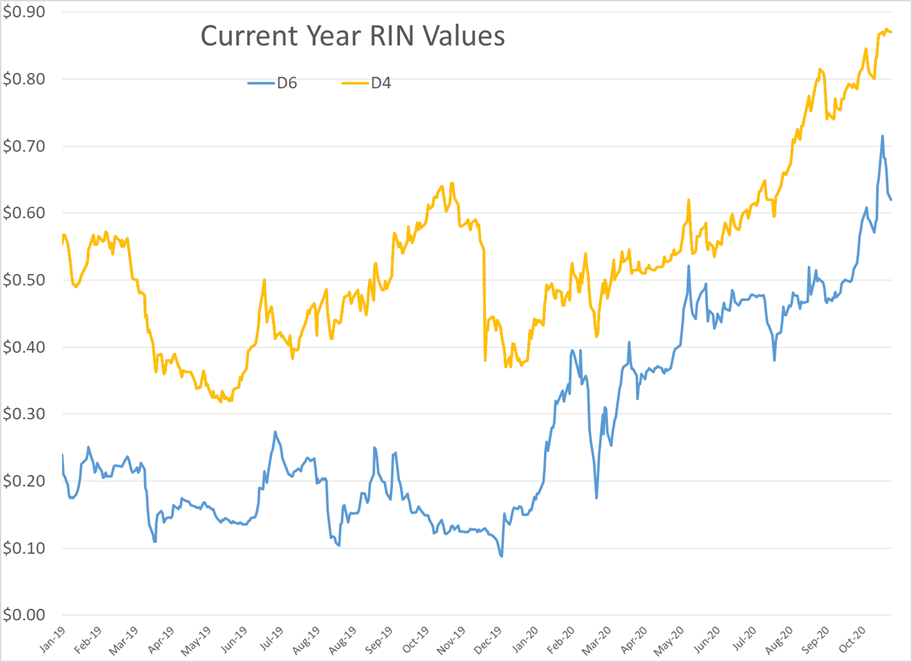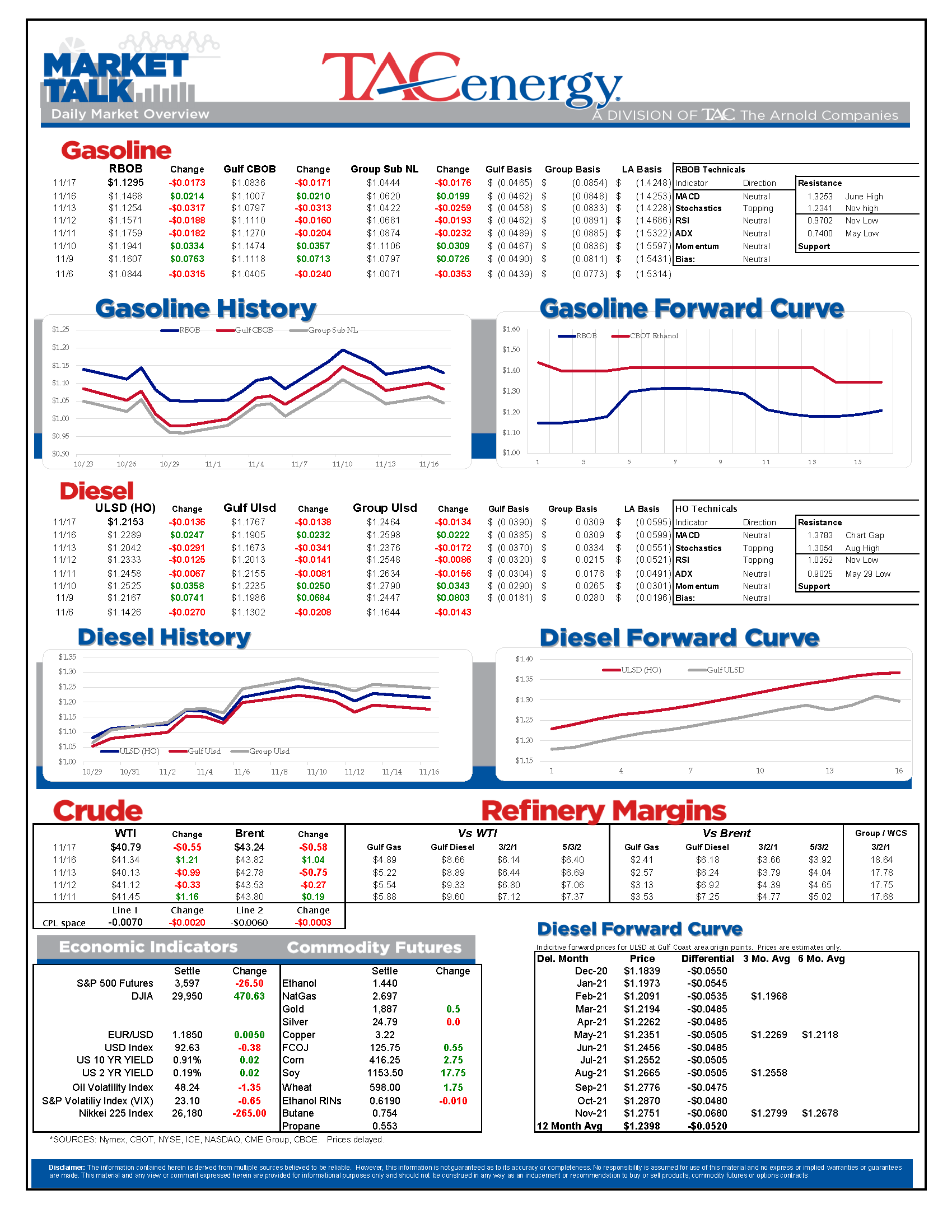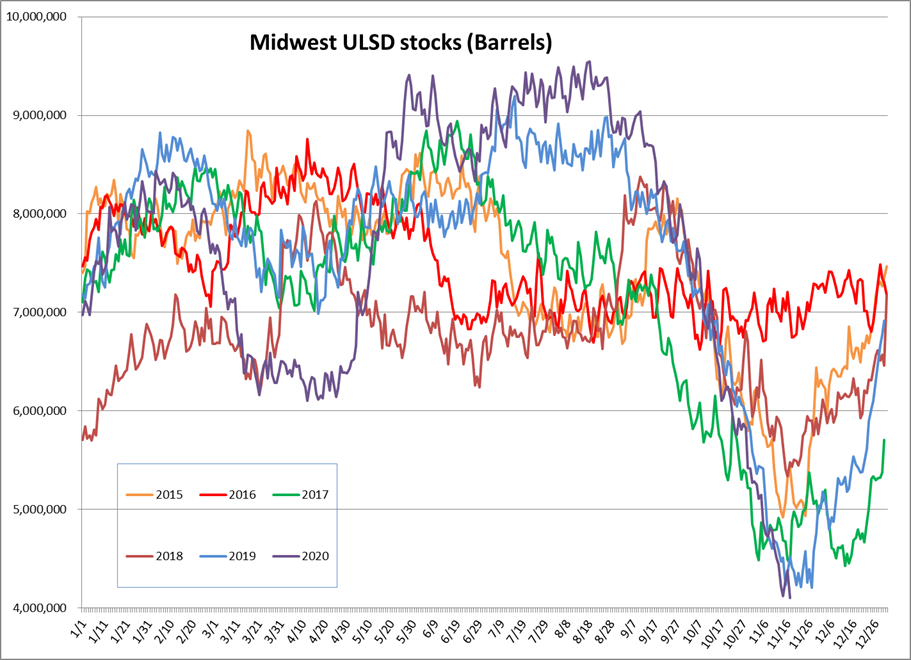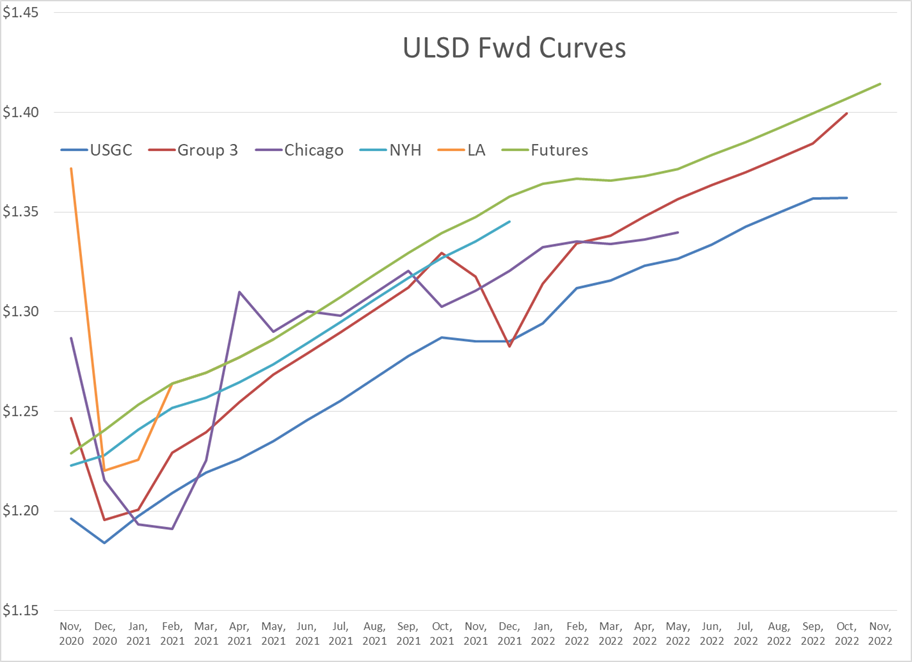Shutdown Pessimism Outweighs Vaccine Optimism

Energy and equity markets are giving back most of Monday’s gains in the early going Tuesday as shutdown pessimism seems to be outweighing vaccine optimism today.
New state-wide restrictions are popping up from coast to coast just ahead of one of the busiest travel weeks of the year, which will certainly put some more downward pressure on fuel demand, although the extent remains to be seen.
After being the weak link in the energy chain for months, distillates have had a strong performance this fall as inventories in several regions dropped to normal levels thanks to a slow recovery in demand and plummeting output from refiners. We can see evidence of that dramatic change in the chart of Midwestern diesel stocks below that shows inventories going from all-time highs in August, to an eight-year-low today. The annual harvest demand peak, and a pull from neighboring states to the West seem to be the major contributors to that rapid drawdown, with W. Texas, New Mexico, Arizona, Colorado and Nevada all finding themselves suddenly short on diesel supply. Cash markets suggest this will be a short-lived phenomenon with steep backwardation into December foreshadowing a recovery in supplies, and the seasonal demand drop, both coming soon.
Reuters is reporting that documents leaked from OPEC’s technical committee make the case for another three to six month extension of the current output cuts. We should find out two weeks from today if that plan is adopted by the cartel.
See this note for a listing of all the refinery closures/conversions announced around the world so far, which total roughly 1.7 million barrels/day of capacity. The exception to the current refining rule of weak margins appears to be China, as the country’s plants reached another output record in October amidst healthy domestic demand.
U.S. refiners are not so lucky, and are facing yet another new challenge as the ordered shut down of Enbridge’s line 5 puts more plants in MI and OH at an even greater risk of being unable to operate economically, although it could be a life saver for other refiners in the mid-continent who have the logistics in place to make a home for that newly distressed crude oil coming from western Canada.
The line 5 saga is just one of several pieces of political theater impacting energy markets since the election. RIN values had been on a tear since the renewable friendly Presidential victory was called, but D6 values have pulled back sharply this week after the EPA administrator said RIN values were “out of control” and that the agency would not release RVO targets for 2021 by the Nov. 30 deadline.
In addition, nominations for drilling in ANWR have been opened up, leaving just enough time for potential leases to be signed before the presidential inauguration. The flurry of events in the past few days suggests we are likely to see more moves from the democratically warring factions in the weeks ahead.
Click here to download a PDF of today's TACenergy Market Talk.
Latest Posts
Crude Oil Inventories Climbed Above Year-Ago Levels For The First Time In 2024
Week 17 - US DOE Inventory Recap
The Energy Complex Is Trading Modestly Lower So Far This Morning With WTI Crude Oil Futures Leading The Way
Energy Futures Are Drifting Quietly Higher This Morning
Social Media
News & Views
View All
Crude Oil Inventories Climbed Above Year-Ago Levels For The First Time In 2024
Sell by May then go away.
The old trading adage looked good for energy markets in 2024 as the new month started off with the biggest daily sell-off of the year so far. WTI and ULSD contracts are now in “rally or else” mode on the charts with sharply lower prices a strong possibility now that technical support layers have broken down. RBOB doesn’t look quite as bearish on the charts, but seasonal factors will now act as a headwind as we’re well into the spring peaking window for gasoline prices, and we’ve already seen a 27 cent drop from the highs. If RBOB can hold above $2.50 there’s a chance to avoid a larger selloff, but if not, a run towards $2.20 for both gasoline and diesel looks likely in the months ahead.
The selling picked up steam following the DOE’s weekly report Wednesday, even though the inventory changes were fairly small. Crude oil inventories continue their steady build and climbed above year-ago levels for the first time in 2024. Demand for refined products remains sluggish, even after accounting for the RD consumption that’s still not in the weekly reports, and most PADDs are following a typical seasonal inventory trend. The Gulf Coast saw a healthy build in diesel inventories last week as the export market slowed for a 3rd straight week. Refinery runs dipped modestly last week following a handful of upsets across the country, but overall rates remain near normal levels for this time of year.
The Transmountain pipeline expansion began operations yesterday, completing a 12-year saga that has the potential to materially change refining economics for plants in the US that relied heavily on discounted Canadian crude to turn profits over the past decade.
The P66 Borger refinery reported another operational upset Monday that lasted a full 24 hours impacting a sulfur recovery unit. Last week the company highlighted how the plant’s fire department helped the surrounding area when the largest wildfire in state history came within feet of the facility.
The EPA approved a new model to determine life cycle carbon intensity scores this week, which cracks open the door for things like ethanol to SAF, which were previously deemed to not reduce emissions enough to qualify for government subsidies. The new model would require improved farming techniques like no-till, cover crop planting and using higher efficiency nitrogen fertilizer to limit the damage done by farms that no longer rotate crops due to the ethanol mandates. Whether or not the theoretical ability to produce SAF comes to fruition in the coming years thanks to the increased tax credit potential will be a key pivot point for some markets that find themselves with too much RD today, but could see those supplies transition to aviation demand.
The FED continues to throw cold water on anyone hoping for a near term cut in interest rates. The FOMC held rates steady as expected Wednesday, but also highlighted the struggles with stubbornly high inflation. The CME’s Fedwatch tool gave 58% odds of at least one rate cut by September before the announcement, and those odds have slipped modestly to 54% this morning.

Week 17 - US DOE Inventory Recap

The Energy Complex Is Trading Modestly Lower So Far This Morning With WTI Crude Oil Futures Leading The Way
The energy complex is trading modestly lower so far this morning with WTI crude oil futures leading the way, exchanging hands $1.50 per barrel lower (-1.9%) than Tuesday’s settlement price. Gasoline and diesel futures are following suit, dropping .0390 and .0280 per gallon, respectively.
A surprise crude oil build (one that doesn’t include any changes to the SPR) as reported by the American Petroleum Institute late Tuesday is taking credit for the bearish trading seen this morning. The Institute estimated an increase in crude inventories of ~5 million barrels and drop in both refined product stocks of 1.5-2.2 million barrels for the week ending April 26. The Department of Energy’s official report is due out at it’s regular time (9:30 CDT) this morning.
The Senate Budget Committee is scheduled to hold a hearing at 9:00 AM EST this morning regarding a years-long probe into climate change messaging from big oil companies. Following a 3-year investigation, Senate and House Democrats released their final report yesterday alleging major oil companies have internally recognized the impacts of fossil fuels on the climate since as far back as the 1960s, while privately lobbying against climate legislation and publicly presenting a narrative that undermines a connection between the two. Whether this will have a tangible effect on policy or is just the latest announcement in an election-yeardeluge is yet to be seen.
Speaking of deluge, another drone attack was launched against Russian infrastructure earlier this morning, causing an explosion and subsequent fire at Rosneft’s Ryazan refinery. While likely a response to the five killed from Russian missile strikes in Odesa and Kharkiv, Kyiv has yet to officially claim responsibility for the attack that successfully struck state infrastructure just 130 miles from Moscow.
The crude oil bears are on a tear this past week, blowing past WTI’s 5 and 10 day moving averages on Monday and opening below it’s 50-day MA this morning. The $80 level is likely a key resistance level, below which the path is open for the American oil benchmark to drop to the $75 level in short order.
Click here to download a PDF of today's TACenergy Market Talk.




